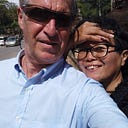The GBA: Innovation driven high-quality development, technology self-reliance
You can watch a video of this article here: https://youtu.be/El9k0RzeqMA
Until recently, I thought a Unicorn was a non-existent mythical animal then I found that there are, at last count, 43 of them living in the Greater Bay Area, the GBA, where I live.
Unicorns, in a business sense, are start-ups with a market capitalisation of over a billion dollars and there are, according to Statistica, about 500 of them in the world. How is it possible to find almost 10% of all the Unicorns of the world in one area of China which is only half the size of England?
The GBA may be a relatively small area, it consists of 9 Guangdong cities and the two SARs of Hong Kong and Macau but the combined GDP of the Area recently exceeded 2 billion USD and that means it has overtaken Italy, which has the 9th highest nominal GDP in the world.
This has come about because of government policies. In March 2022, China announced an Innovation Development Strategy that would add to the ongoing commitment to further Opening and Reform.
Several key strategies were proposed and, since then, those proposal have already been implemented. One was to remove bottlenecks from supply chains. In a meeting, held by Liu He, perhaps the most important man in terms of China’s current economic policy and described as a right hand man to President Xi, it was proposed to spend $157 billion USD to solve the current issues with logistics and improve efficiencies in technology and transportation. When Liu He proposes it, we know, unlike some countries where this will get bogged down in partisan debates, this will be done.
A very important part, as defined by Xi Jinping himself is the development of talent. Overseas students returning to China, of which there are almost 600,000 a year, skilled workers trained in China, of which there are over 200 million and 50 million described as highly skilled and China’s own university graduates, amazingly, there are currently over 35 million of them. Imagine that, that’s 10% more than the population of Australia and New Zealand combined studying in university, will contribute to the country’s ongoing development.
Research and Development is crucial and, according to the Global Innovation Index Ranking, China has, for the last 8 years in a row ranked first in the world for the number of people involved in this aspect of future development. In the same report, it also mentioned that China ranks first in patent applications too, with over 68,000 applications in 2020 and that number increases every year.
But the most important thing is the new policies to attract foreign talent. These include fast tracking to green card status, tax incentives for people coming into the region from the SARs, employment opportunities for overseas students graduating from Chinese universities and better living, medical and educational facilities for families and, of course, globally competitive sallies and working conditions.
In essence, what China is doing is establishing a sense of reliance on its own, indigenous production and domestic consumption that some in the west view as threatening, but that’s most in China view as common sense.
